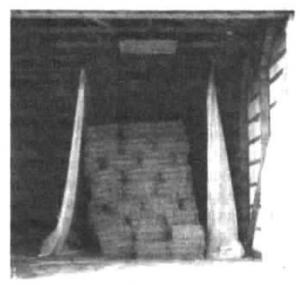1995 - Volume #19, Issue #3, Page #06
[ Sample Stories From This Issue | List of All Stories In This Issue | Print this story
| Read this issue]
Hay Drier Uses Vacuum To Dry
 |
Trauttmansdorff works for Ontario's Dunlea Farms Ltd., a supplier of hay for the Canadian and U.S. horse markets. "Last year we put half our production - 40,000 14 by 18 by 38-in. bales - through it. We've found we can consistently dry hay from 25 or 30% moisture down to around 15% in 24 to 36 hours for $6 to $10 per ton, assuming a natural gas cost of 18 cents per 35 cu. ft. and electric at 8 cents per kwh. That's about half of what it costs in LP and electricity with a forced air batch drier."
Edwin Arinze, an ag engineer at the University of Saskatchewan, has tested Dunlea Farms' system and was impressed with its performance.
"It provides more uniform air distribution - and therefore more uniform quality - through the hay than is possible with forced air systems," says Arinze.
Key to success of the system, Arinze and Trautmansdorff agree, is the way long poly curtains tightly seal against the hay-stack once drying begins.
There are two drying bays in a 40 by 64 by 20-ft. high pole barn that houses the system. A 37-ft. long by 60-in. wide plenum, with a pair of hinged 42-in. wings, mounts in the roof of the building. Once the bales are in place, the wings swing down against the stack - via boat winches and cable - and 20-ft. poly curtains are pulled together to surround the stack.
A 900,000 Btu grain drier burner feeds hot air into the plenum. It's then pulled down through the bales by a 12 1/2 hp fan in a 4 by 4 ft. duct under the floor.
The suction "vacuum packs" curtains tightly around the stacks.
Moist air is exhausted out of the building, while warm air is recaptured with a heat exchange.
Hay temperature and moisture are con-trolled with readings and testers. Once hay reaches its desired moisture level, it's cooled by moving outside air through it for about two hours.
Hay is moved in and out of the drier 160 bales at a time with a stack mover. Between the two bays, the system is capable of drying 1600 bales, or 40 tons of hay, per day.
The system cost $50,000 to $60,000 (Canadian) for the drier and building and was custom-designed for Dunlea Farms. The operation produces 80,000 bales from 400 to 500 acres of alfalfa/timothy hay a year.
Trauttmansdorff has customized "how to" packages available and he's looking for a manufacturer to produce the system.
Contact: FARM SHOW Followup, Fritz Trauttmansdorff, Dunlea Farms Ltd., R.R. 1, Jerseyville, Ontario, Canada L0R 1R0 (ph 519 647-2311; fax 647-3300).

Click here to download page story appeared in.

Click here to read entire issue
To read the rest of this story, download this issue below or click here to register with your account number.




